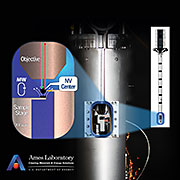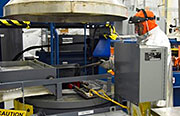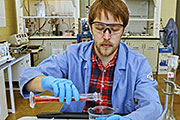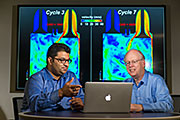On Dec. 27, 2004, Rob Mitchell was driving through Sadr City, Iraq, with the US Army’s 1st Cavalry Division, headed toward a nearby base exchange where he and his team planned to buy snacks and CDs. He was behind the wheel of the third Humvee in a three-vehicle convoy when everything suddenly turned brown.
“It was like I’d driven into a sandstorm. I didn’t hear anything, see anything, or feel anything. Everything was just brown,” he recalls. The dust settled, and he realized his convoy had been hit by an improvised explosive device, an IED.
Rob’s best friend, a gunner in the second vehicle, was killed in the attack and several others in the convoy were severely wounded. The Humvee’s ballistic glass windshield saved Rob’s life when it prevented an airborne ball bearing from hitting him. This was the third IED Rob had survived during his year in Iraq.
Full Story
When you’re trying to understand the complex inner workings of a virtual engine, with its millions of variables and untold number of uncertainties, the most important horsepower number isn’t the one under the hood; it’s the one in the computer rack next door.
Researchers at the U.S. Department of Energy’s Argonne National Laboratory will be testing the limits of computing horsepower this year with a new simulation project from the Virtual Engine Research Institute and Fuels Initiative (VERIFI) that will harness 60 million computer core hours to dispel those uncertainties and pave the way to more effective engine simulations.
The work will be conducted on MIRA, which is currently the fifth-fastest supercomputer in the world and serves as the epicenter of the Argonne Leadership Computing Facility, a DOE Office of Science User Facility. VERIFI has been working for two years to gain a deeper understanding of the complex dynamics at work in engine combustion. While VERIFI has used powerful computers before, it has never accessed a computer with the horsepower of MIRA and the abilities to unlock the deepest secrets of combustion.
Full Story
 As the demand grows for ever smaller, smarter electronics, so does the demand for understanding materials’ behavior at ever smaller scales. Physicists Ames Laboratory are building a unique optical magnetometer to probe magnetism at the nano- and mesoscale.
As the demand grows for ever smaller, smarter electronics, so does the demand for understanding materials’ behavior at ever smaller scales. Physicists Ames Laboratory are building a unique optical magnetometer to probe magnetism at the nano- and mesoscale. Marking an important step toward the advancement of a new type of reactor, employees at DOE's Idaho National Laboratory recently completed the first successful test of fabrication equipment in the Experimental Fuels Facility (EFF) at INL’s Materials and Fuels Complex. Specifically, they finished the first extrusions of depleted uranium — a process of shaping material by forcing it through a die.
Marking an important step toward the advancement of a new type of reactor, employees at DOE's Idaho National Laboratory recently completed the first successful test of fabrication equipment in the Experimental Fuels Facility (EFF) at INL’s Materials and Fuels Complex. Specifically, they finished the first extrusions of depleted uranium — a process of shaping material by forcing it through a die. A catalyst being developed by researchers at DOE’s Oak Ridge National Laboratory could overcome one of the key obstacles still preventing automobile engines from running more cleanly and efficiently.
A catalyst being developed by researchers at DOE’s Oak Ridge National Laboratory could overcome one of the key obstacles still preventing automobile engines from running more cleanly and efficiently.

